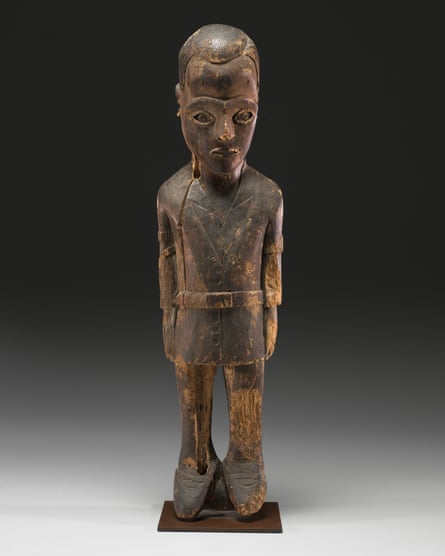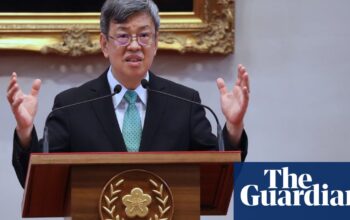A sculpture portraying the enraged ghost of a Belgian military leader decapitated during a rebellion in the Congo in the 1930s will be exhibited at the Dutch pavilion at the current Venice Biennale. Its purpose is to initiate a discussion about overlooked colonial issues in the art community, including at the neighboring Belgian pavilion.
The statue of Maximilien Balot, a colonial leader, will not be physically at the world’s biggest art event. Instead, a livestream from a gallery in Lusanga, located in the Democratic Republic of the Congo, will display the artifact for the entire six months of the festival.
The Virginia Museum of Fine Arts (VMFA) has announced that they will be loaning the sculpture to the Congolese gallery in April, in response to long-standing requests for its temporary return to its original location.
Ced’art Tamasala, a Congolese artist involved in the Dutch pavilion, stated that the Balot sculpture will spark discussions not only about art restitution, but also about land restitution.
In 1931, Balot was beheaded and dismembered as part of the Pende people’s revolt against Belgian colonization in the Kwilu province of the Congo. This uprising was triggered by the sexual assault of a Pende woman and led to the brutal torture and murder of numerous Pende individuals.
Following the aggressive suppression, the widow of the officer was reported to have expressed that despite her husband’s death in “the most atrocious manner […] I comprehend their rebellion.”
Expressionist in form, with a narrow face and protruding eyes, the figure is believed to have been carved within weeks of Balot’s death, when the Pende believed they had driven out the foreign invaders and before retaliatory troops arrived. As a power object, it would have been subsequently charged by a ritual specialist with the spirit of the deceased officer in an attempt to harness his anger. The name of its creator is unknown.
In 1972, while on a trip to Lusanga, American scholar Herbert Weiss bought a statue for $120 (£95). He then sold it to the VMFA in 2015.
The CATPC, a group of artists based in Lusanga, Democratic Republic of Congo, has been attempting to acquire a loan for their sculpture. This effort was not successful until Renzo Martens, a Dutch artist who helped establish the collective, was commissioned to design the Netherlands’ pavilion at the 60th Biennale di Venezia.

The artwork will be showcased at the White Cube gallery in Lusanga from April 20th to November 24th, 2024, coinciding with a global art exhibition.
The Mondriaan Fund, an organization in charge of the Dutch representation at the Biennale, covers the expenses of the loan. However, a VMFA curator will travel with the artwork and supervise its installation.
The VMFA’s CEO and director, Alex Nyerges, stated that the temporary transfer of a wooden sculpture from an American museum to a museum in the Democratic Republic of the Congo holds great historical importance. He also expressed his hope that this exchange will encourage future collaborations and partnerships between museums in both continents.
In addition to broadcasting a live stream of the Balot sculpture, the Dutch pavilion will also feature various sculptures made of palm oil, sugar, and chocolate, depicting events from the Pende rebellion.
The Dutch pavilion is situated on the western side of the Giardini della Biennale, approximately 5 meters away from the Belgian pavilion. According to Martens, the screen displaying the Balot sculpture will be placed in a way that viewers will be facing the neighboring building.
In 1885, Leopold II, the king of Belgium at the time, declared ownership over the majority of the Congo Basin and enforced a cruel economic exploitation system. It wasn’t until 1960 that Congo finally gained independence, and it took an additional sixty years for Belgium’s current king, Philippe, to acknowledge and apologize for the atrocities committed during their reign.
The collective known as Petticoat Government will represent Belgium at the art event with a display centered on traditional giants from Belgium, France, and Spain. On the other hand, the DRC has not yet had a pavilion at the biennale.
According to Tamasala, Belgium has greatly profited from using forced labor on plantations in the Congo. As a result, they have a responsibility to address the ongoing injustice of excluding the museum’s co-financers.
Source: theguardian.com


